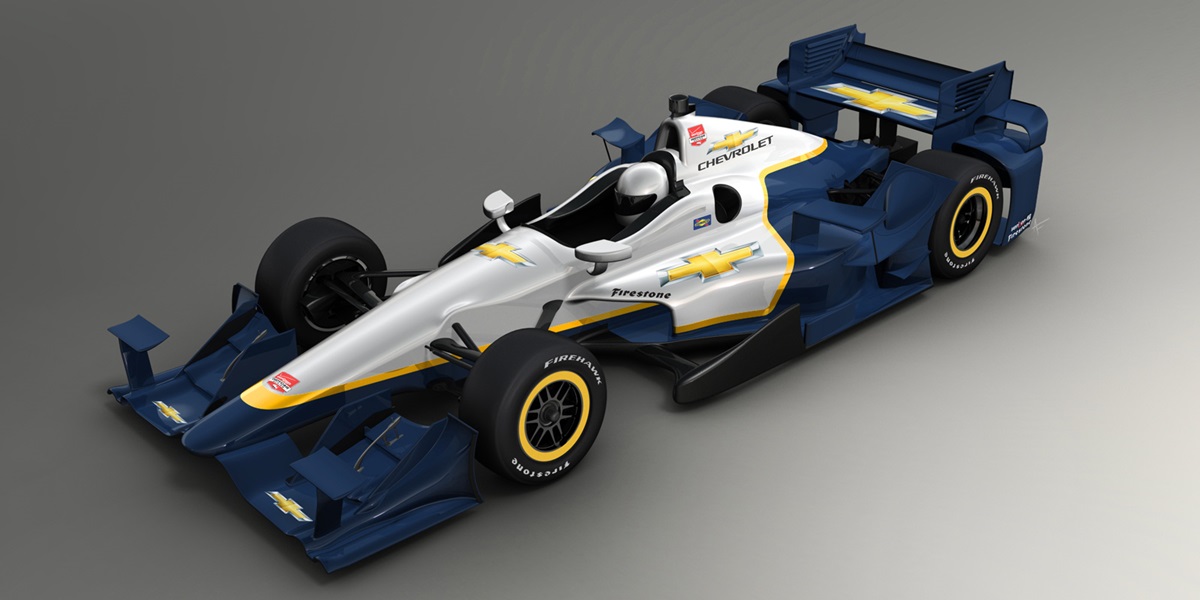
Chevrolet Unveils Aero Kit for 2015 Verizon IndyCar Series Season
February 17, 2015 | By Verizon IndyCar Series
Chevrolet is prepared for the next bold step in manufacturer competition with the introduction of aerodynamic bodywork kits to the Verizon IndyCar Series, according to Jim Campbell, GM’s U.S. vice president of performance vehicles and motorsports.
Campbell was joined by Chevrolet Racing director Mark Kent and Chris Berube, Chevrolet Racing's IndyCar program manager, in unveiling renderings of its road/street course and short oval aerodynamic package during the Verizon IndyCar Series media day on Tuesday at the Indianapolis Motor Speedway. A speedway configuration will be introduced ahead of its competitive debut in May at the 2.5-mile Indianapolis Motor Speedway oval.
“This is an important milestone in Chevrolet’s involvement in IndyCar racing,” Campbell said. “We focused on developing an aerodynamic package that delivers an optimal balance of downforce and drag, along with integrated engine performance. It’s a total performance package.”
The Firestone Grand Prix of St. Petersburg marks INDYCAR’s introduction to chassis competition in the Verizon IndyCar Series based upon aerodynamic bodywork components designed, manufactured and supplied by Chevrolet and Honda. Cars will be differentiated by their shape on the 1.8-mile temporary street course. References to the cars will incorporate the name of the corresponding manufacturer.
The road/street course and short oval configuration’s changes over the 2014 Dallara IR-12 package are easily identified by major components, including:
- Front wing that features new pedestal-mounted “front uppers” toward the outer edges.
- New sculpted “wheel wedges” in front of the rear tires.
- An engine cover and sidepods that have more compact shapes, achieved through a revised turbocharger and exhaust system layout.
- New larger rear bumper pods.
- A multi-element upper rear wing, along with louvered end plates.
“This new aero kit provides Chevrolet drivers the capability to enter and exit corners faster, while maintaining high speeds on the straights,” Berube said.
Development of the 120-plus parts consisted of nine key phases:
- Baseline analysis of the Dallara IR-12 aerodynamics.
- Establishing clear design goals for the new aero kit, which included making the most of downforce, drag and engine performance.
- Developing design concepts using computer-aided design.
- Analyzing structural properties, using finite element analysis.
- Simulated aerodynamic properties using computational fluid dynamics.
- Produced test parts using rapid prototyping processes, such as 3D printing.
- Conducting testing of a 50 percent scale model in a rolling road wind tunnel.
- Conducting testing of a full-scale race car in a rolling road wind tunnel.
- Conducting track testing of prototype aero kit on select racetracks, including Homestead-Miami Speedway, Circuit of The Americas (Austin, Texas), Texas Motor Speedway and Phoenix International Raceway.
“We took a clean-sheet approach to the aero kit, delivering an optimized and efficient design that should really give our Chevrolet teams an edge,” Berube said.
The manufacturer on-track testing window opened Oct. 6 and closed Jan. 18 -- the same date as homologation of components. Chevrolet and Honda teams are due to received the full-scale road/street course and oval aero kits March 1. Team on-track and wind tunnel testing is allowed starting March 13. Promoter Day testing is scheduled for March 16-17 at Barber Motorsports Park.
"When we decided to come back into the series leading into 2012, we really worked with INDYCAR on a few priorities," Campbell said. "We love the engine formula in this series, smaller displacement engines, direct injection, boosting, turbo charging, use of smaller V6 powerful engines, then use of a biofuel. We came with a 2.2-liter twin-turbo direct-injector V6. That was one of the key reasons we came back in the series and why we still love the series. It relates to what we sell in the showrooms that delivers that great combination of power, fuel economy and durability.
"Secondly, we were looking to bring world-class racing to the City of Detroit with Belle Isle. We appreciate the support of INDYCAR to make that happen. We'll be kicking off our fourth season. "Finally, we wanted to come back in IndyCar because we had the opportunity to develop aero kits. It was our opportunity to differentiate our look, drive innovation, look for ways to improve performance and speed, lap times. That's exactly what we've been doing."
The speedway aero kits are to be delivered to teams April 1.